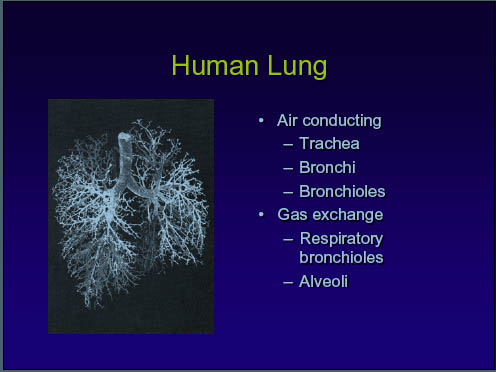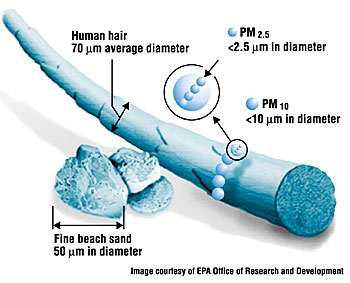Relative Sizes of Particles and Comparison of Dimensional Units
1 micron is a millionth of a meter or 1 inch divided into 25,400 parts.
| Substance | Micro-meters (microns) | Inch |
| 90% of Wood smoke particles are smaller than | 1 micron | 0.00004 |
| Bacteria (average) | 2 | 0.00008 |
| Red Blood Cell | 8 | 0.0003 |
| Talcum Powder | 10 | 0.0004 |
| White Blood Cell | 25 | 0.001 |
| Human Hair | 70 | 0.003 |
| Grain of Table Salt | 100 | 0.004 |
Particulate pollution in the past decade has been measured as PM10, that is particulate matter 10 microns in diameter or less, which is talcum powder size. Recently the focus has shifted to smaller diameter particles, PM2.5, which denotes all particles 2.5 microns and smaller (bacteria sized). These small sizes are thought to be more injurious because they are deeply respirable, becoming lodged in the farthest recesses of the lungs. Smoke from wood combustion is almost entirely in this range.
 US EPA
US EPA
"Contribution of wood smoke to air particle pollution.
In winter, there is more
air particle pollution caused by wood smoke than any other single
source. ... "
www.epa.nsw.gov.au/woodsmoke/default.htm - 23k

Wood smoke particle taken from a human lung enlarged. Original picture size 3 7/8 " by 3 3/8" at 900x enlargement. Chest p.1232. Interstitial Lung Disease and Domestic Wood Burning, Ramage, Roggli, Bell and Piantadosi.
The wood smoke particle swells up inside the body. Hygroscopic Growth of Assorted Indoor Aerosols, S.K. Dua, P. K. Hopke: Aerosol Science and Technology 24:151-160, 1996:Abstract: The hygroscopic growth of particles produced from four different kinds of oils during deep frying, from sausages during grilling, and from burning wood in a stove was studied using a Tandem Differential Mobility Analyzer. The size distributions and the soluble fractions of the particles were also measured. The median diameters of the particles from the oils were in the range of 168-200 nm and those from the sausages and the wood in the range of 55-80 nm. The median diameter and the geometric standard deviation of the particles from wood depended on wood burning with or without a flame. The soluble fractions of the particles from the oils were between 8% and 22%, and those from soluble fraction for particles from the sausages was 46%. The wood smoke showed significant growth, between 70% and 92%. Journal full paper: Hygroscop-Hopke-Dua (PDF) and the charts are available as a separate PDF courtesy of Prof. Hopke. (See Fig. 16 for the growth of the wood smoke stove particle.) A good description of this study was in the newsletter of Center for Indoor Air Research. "Measurement of the Hygroscopicity of the Indoor Aerosol" by Prof. P.K. Hopke,. Aug. 1996. "The Wood Smoke (woodsmoke) particle is different than cooking oil aerosols, in that it swells up inside the 99% humidity of the lung. This means that it could "deposit a higher load" of the combustion toxics directly into the lung." (Dept. of Chemistry, Clarkson University, Potsdam, NY). [The above article is actuall a scanned image in jpg format. It can be saved from your browser if you wish to print it.]
Other studies have confirmed the growth of wood smoke particles with high humidity.

